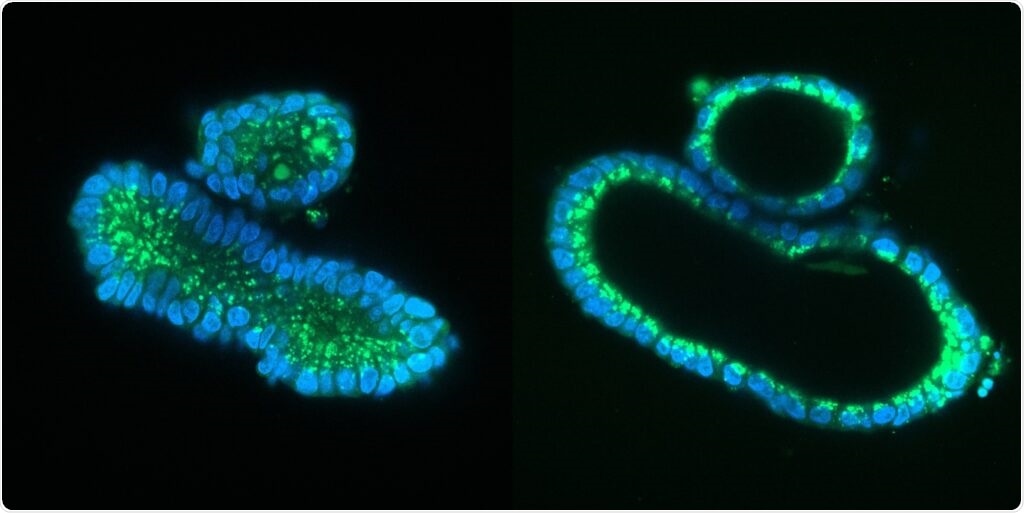A team of scientists headed by Hans Clevers from the Hubrecht Institute rectified mutations that result in cystic fibrosis in cultured human stem cells. In association with the UMC Utrecht and Oncode Institute, the researchers employed a technique named prime editing to replace the “faulty” piece of DNA with a healthy piece.

Swelling response of patient-derived mini-guts. Collapsed organoids (left) show active swelling response that is mediated by the CFTR ion channel after 1 hour incubation with forskolin (right). Green staining shows complete cells (Calcein green) and DNA is shown in Blue. Image Credit: Eyleen de Poel, © UMC Utrecht.
The research was published on August 9th, 2021, in the journal Life Science Alliance. The study reveals that prime editing is safer than the traditional CRISPR/Cas9 technique.
We have for the first time demonstrated that this technique really works and can be safely applied in human stem cells to correct cystic fibrosis.”
Hans Clevers, Group Leader, Hubrecht Institute
Cystic fibrosis (CF) is one of the most common genetic diseases with serious implications for the patient. The mucus in the throat, intestines, and lungs is sticky and thick, which results in blockages in organs. Even though treatments are available to dilute the mucus and prevent inflammations, CF is not yet curable.
But now, researchers headed by Hans Clevers (Hubrecht Institute) worked with the UMC Utrecht and Oncode Institute to provide new promises.
Correcting CF mutations
The scientists successfully corrected the mutations that result in CF in human intestinal organoids. These organoids, also known as mini-organs, are tiny 3D structures that mirror the intestinal function of patients with CF. The organoids were earlier created by the same research team from stem cells of patients with CF and stored in a biobank in Utrecht.
The current research published in the Life Science Alliance journal employs a method called prime editing to replace the piece of mutated DNA that results in CF with a healthy piece of DNA in these organoids.
Safer than CRISPR/Cas9
Prime editing is a more recent version of the well-known gene-editing technique CRISPR/Cas9. CRISPR/Cas9 splices the DNA before correcting it. Even though this corrects the mutated piece of DNA, it also causes damage in other regions in the genome.
In our study, prime editing proves to be a safer technique than the conventional CRISPR/Cas9. It can build in a new piece of DNA without causing damage elsewhere in the DNA. That makes the technique promising for application in patients.”
Maarten Geurts, Study First Author, Hubrecht Institute
Swelling
The mutations that result in CF are found in the Cystic fibrosis transmembrane conductance regulator (CFTR) channel, which is present in the cells of different organs including the lungs. The channel does not function properly, due to the mutations, leaving the layer of mucus that covers the cells with too little water—the mucus becomes sticky.
The addition of a substance named forskolin causes healthy organoids to swell; however, this does not occur in organoids with mutations in the CFTR channel.
“We applied prime editing to the mutations, after which the treated organoids demonstrated the same response as the healthy organoids: they became swollen. That provided us with proof that our technique worked and replaced the mutated DNA,” explained Geurts.
Curing genetic diseases
The study findings reveal that the mutations that result in CF can be safely corrected, and applications in the clinic are a step closer.
New variants of CRISPR/Cas9, such as prime editing, can safely correct mutations without causing damage in other regions of the DNA. This will hopefully enable us to cure or even prevent genetic diseases in the future.”
Maarten Geurts, Study First Author, Hubrecht Institute
However, there are still certain challenges in front of the researchers. The approach, for instance, still needs adaptation for safer use in humans. “But this is a great step towards successfully applying prime editing in the clinic,” added Geurts.
Source:
Journal reference:
Geurts, M. H., et al. (2021) Evaluating CRISPR-based prime editing for cancer modeling and CFTR repair in organoids. Life Science Alliance. doi.org/10.26508/lsa.202000940.